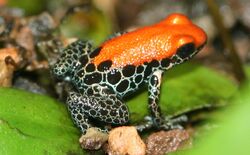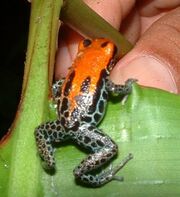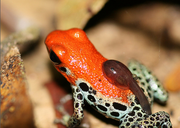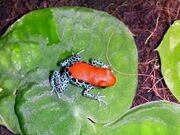| Red-backed poison dart frog | |
|---|---|
 | |
| Physical description | |
| Binomial name | Ranitomeya reticulata |
| Habitat | Tropical rainforest |
| Lifespan | 8-12 years |
| Average Size | 1.5 cm (0.6 in) |
| Average weight | 1.3 grams |
| Diet | Insectivorous |
| Conservational Status | |
| Status | Near threatened |
| IUCN status | 3.1 |
| Scientific classification | |
| Phylum | Chordata |
| Class | Amphibia |
| Order | Anura |
| Family | Dendrobatidae |
| Genus | Ranitomeya |
| Species | R. reticulata |
| Distribution | |
| Distribution of species | Peru |
The red-backed poison dart frog, Ranitomeya reticulata, is a species of poison dart frog. Endemic to Peru, the species is common but in fairly rapid decline, and is listed as Near Threatened by the IUCN. It is kept as an exotic pet, but is much rarer in captivity than many other species.
Poison
Like many Ranitomeya species, the red-backed poison dart frog's toxins are relatively weak. Its skin secretes pumiliotoxin C, a less-potent version of the pumiliotoxins secreted by the Dendrobates and Oophaga species. Pumiliotoxin C, like other pumiliotoxins, interferes with muscle contraction in the heart and skeletal muscle. The very small amount of poison that the mimic poison dart frog carries is nonetheless enough to cause illness in humans.
Pumiliotoxin is deadly in high concentrations. Pumiliotoxin is weaker than allopumiliotoxin and especially batrachotoxin, with a lethal dose of 2 mg (R. reticulata carries about a quarter milligram). There are three different types of this toxin A, B and C. The toxin works by affecting the calcium channels. Some of the symptoms of pumiliotoxins are partial paralysis, having difficulty moving, being hyperactive and in some cases it can result in death.
Description

Handling a wild specimen.
Ranitomeya reticulata is one of the smaller species of poison dart frogs, . Males can reach approximately 12 mm in length from snout to vent, while the larger females may reach 15 mm long. Like all poison dart frogs, R. reticulatus are vividly coloured and patterned, which advertises their poison. Red-backed poison dart frogs have black legs with a cobalt or sky-blue mesh pattern, a black belly, and a back that ranges from fiery orange to scarlet in color, hence the common name. Like all arboreal frogs, reticulata possess suckerlike disks on their toes which makes their grip adhesive. As they are very small, they often attempt to advertise their poison by flaunting such colors or by ascending trees to escape from predators. If isolated from any form of escape, reticulata will use their poison as a defense mechanism. Reticulata are more slimly built than many dendrobatids, which combined with their small size, gives them the ability to squeeze into minute hiding places.
Reproduction
R. reticulata naturally live in groups of five or six. At the end of the wet season, several of these groups join in large breeding gatherings. As with other poison dart frogs, the males court the females by calling to capture their attention, and then by gently stroking and licking them. A female will signal that she is sufficiently impressed by stamping her hind feet. The two frogs will then undergo amplexus.

Wild male specimen with a tadpole on his back. He may be transporting it to a bromeliad, or relocating it to another source of water.
.Once the eggs hatch, the male carries the baby tadpoles into the canopy. The tadpoles have bromeliads. The female will then feed the tadpoles with infertile eggs that she lays into the water. Once the tadpoles become froglets, they are led by their parents to an existing group of red-backed poison frogs. While the young froglets are accepted by all members of the group, only their parents will look after the young frogs.
In Captivity

Captive specimen.
R. reticulata is a difficult poison dart frog to keep due to its small size. Although small, it requires a sizeable vivarium due to its arboreal nature. Its tiny size and relative sensitivity when compared to other Ranitomeya species delegate reticulata as a species best left to more experienced hands. Established animals do best when kept in a warm vivaria with plenty of leaf-litter, and a good arthropod diversity established in the substrate on which the animals will forage.


